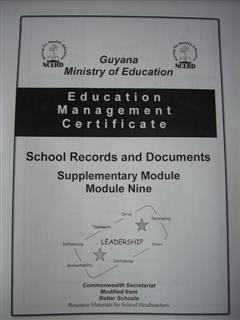.jpg) Introduction
IntroductionAlthough we have made it clear in the last eight modules that the most important aspect of a headteacher’s function is the leadership role, we cannot deny that there is also a need for a certain amount of administration to make sure that schools function smoothly and that appropriate records are kept for those who need them.
This module is a supplementary one and does not form part of the main programme. It is based on the Ministry of Education’s document “School Records and Documents” which has been updated regularly to meet current needs. It is the Ministry’s guidelines for all administrative activity for schools in Guyana. It is an extremely comprehensive guide produced by a large number of persons who wrote it and were part of the consultation process. It gives clear instructions to headteachers on how they should operate in respect of their administrative duties.
Whilst we accept that such administrative tasks are essential in keeping the wheels of the school moving smoothly, we must remember, however, that these tasks are not a means to a successful school in themselves. They assist the headteacher in keeping appropriate records to support him /her to fulfil his / her role as a leader. Alone they will not raise achievement. This is done by coaching, motivating and supporting school staff. School records should be completed, therefore, as far as possible outside of the school day and should not be used as an excuse to avoid working in those areas which will make a real difference to pupil achievement.
The primary purpose of the guidelines is to provide information to school practitioners in an attempt to enhance their competence and confidence. When the guidelines are adhered to, the system of accountability would be greatly improved.
The format of this module is different from that of the previous ones in that each unit will have a short introduction, after which you will be expected to read the appropriate sections of the guidelines. On completion of your reading, you will find a number of reflections and activities which we hope you will complete. We have provided you with a page reference from the guidelines to assist you in this process. The answers to the activities should be recorded in your portfolio in the normal way.
Individual study time: 20 hours
Objectives
After working through this module, you should be:
§ aware of the existence of the Ministry’s guidelines on “School Records and Documents”
§ able to identify the key elements of the guidelines
§ able to use different documents and records as they relate to school administration
§ able to understand the need for records and be able to put them into the wider context in relation to the agenda for raising school effectiveness.
Units
The module is divided into ten main units. These are the core aspects of “School Records and Documents” and not everything is covered in great detail. You should, however, make yourself familiar with every section of the guidelines.
Unit 1: Keeping a log of school activities 2 hours
This unit explains the purpose of and use of the school, departmental, divisional and year group logs.
Unit 2: Attendance of teachers and learners 2 hours
You are provided here with all of the necessary forms and examples of records to be kept to keep a track of the attendance of your staff and your pupils
Unit 3: Organisational Charts 2 hours
Here you will find examples of all of the main organisational charts required in Secondary, Primary and Nursery schools in Guyana.
Unit 4: Vision, Mission, Improvement and Planning 2 hours
You will find in this unit how to record your school’s vision and mission as well as the decisions you have made about school improvement and planning for the school year.
Unit 5: Pupil Records and Orientation 2 hours
This unit will help you to keep track of every aspects of your school’s pupil enrolment as well as how to provide a quality orientation for new students.
Unit 6: Staff Conduct and Orientation 2 hours
The guidelines provide you with the appropriate documents for the conduct of staff and how to provide a worthwhile orientation for new staff.
Unit 7: Timetable and Teacher Record-keeping 2 hours
Here you are shown the correct way of constructing and displaying a timetable as well as the records you should insist upon from your teaching staff.
Unit 8: Supervision 2 hours
This unit explains the supervisory schedule and the records you must keep in carrying it out.
Unit 9: Equipment and furniture 2 hours
Here you will find details of how to record, maintain and dispose of school property as required.
Unit 10: Pupil Assessment 2 hours
This section outlines the procedures to be followed for the internal and external assessment of your pupils.